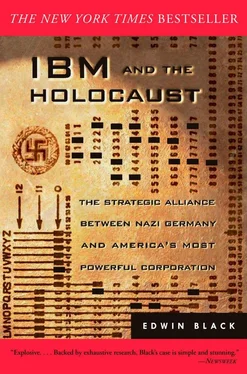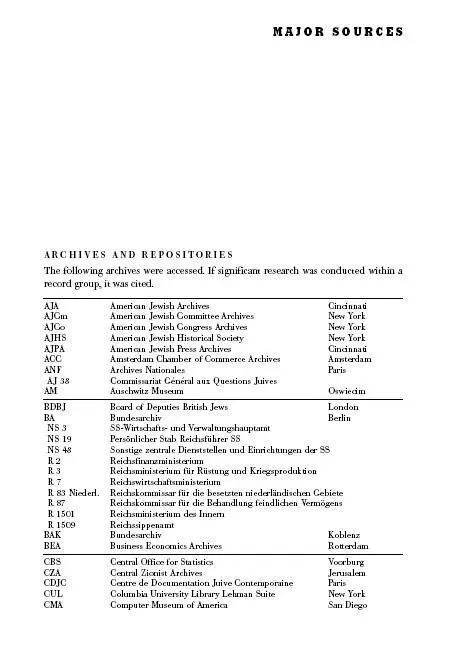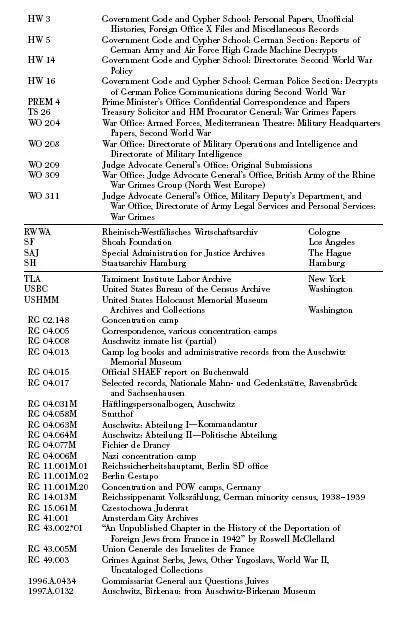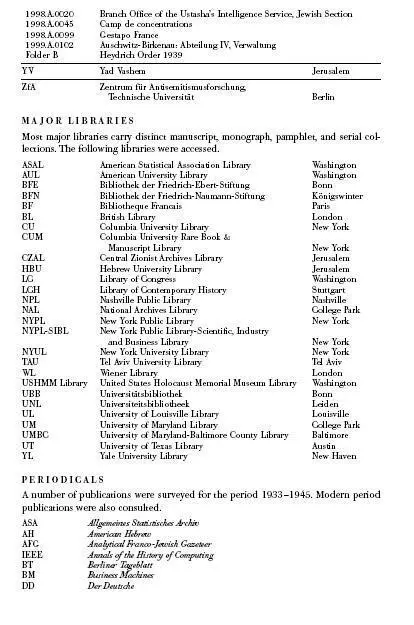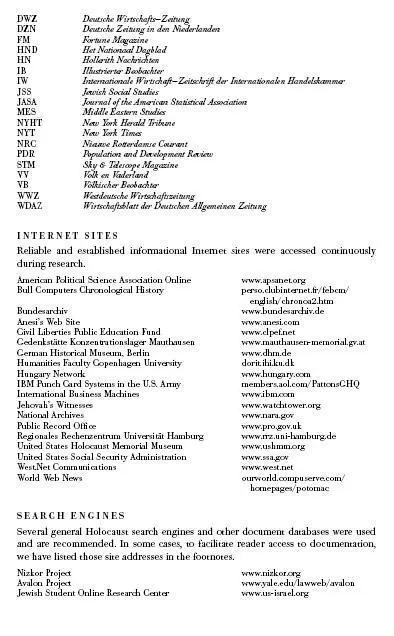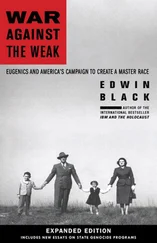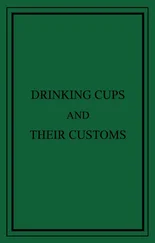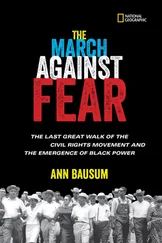9. Handwritten tally, Buchenwald Abteilung Hollerith, August 23, 1944, Kommando 68, Blatt 66-73, International Tracing Service of the Red Cross Archive, in Buchenwald Archive 56-2-31; handwritten Prisoner Roster, Buchenwald Abteilung Hollerith, circa August 23, 1944, Kommando 68, Blatt 66-73, International Tracing Service of the Red Cross Archive, in Buchenwald Archive 56-2-31; Handwritten tally, Buchenwald Abteilung Hollerith, August 27, 1944, Kommando 68, Blatt 66-73, International Tracing Service of the Red Cross Archive, in Buchenwald Archive 56-2-31; Handwritten tally, Buchenwald Abteilung Hollerith, August 31, 1944, Kommando 68, Blatt 66-73, International Tracing Service of the Red Cross Archive, in Buchenwald Archive 56-2-31.
10. Memo, Arbeitseinsatz Ravensbruck to Kommandantur—Arbeitseinsatz Buchenwald, November 17, 1944, International Tracing Service of the Red Cross Archive, in Buchenwald Archive 63-0-4.
11. Memo, WVHA Amt D-II to Kommandantur—Buchenwald, January 25, 1945, Buchenwald Archive, 46-1-19.
12. Handwritten tally, Buchenwald Abteilung Hollerith, February 2, 1945, Kommando 68, Blatt 66-73, International Tracing Service of the Red Cross Archive, in Buchenwald Archive 56-2-31; Typed tally, Buchenwald Abteilung Hollerith, February 13, 1945, Kommando 68, Blatt 66-73, International Tracing Service of the Red Cross Archive, in Buchenwald Archive 56-2-31.
13. Anderungliste 19 for Week 51, from Sachsenhausen to Oranienburg, December 17-23, 1944, Russian State Military Archive, FOND 1367/1/196, in Sachsenhausen Archive D1A, vol. 195, p. 56 back. Anderungliste unnumbered for Week 49, from Gross-Rosen to Oranienburg, November 26-December 3, 1944, Russian State Military Archive, FOND 1367/1/196, in Sachsenhausen Archive D1A, vol. 195, p. 57 front.
14. Anderungliste 19 for Week 51, from Sachsenhausen to Oranienburg, December 17-23, 1944, Russian State Military Archive, FOND 1367/1/196, in Sachsenhausen Archive D1A, vol. 195, p. 56 back. Anderungliste unnumbered for Week 49, from Gross-Rosen to Oranienburg, November 26-December 3, 1944, Russian State Military Archive, FOND 1367/1/196, in Sachsenhausen Archive D1A, vol. 195, p.57 front.
15. Commemorative Program, “Luncheon in Honor of Thomas J Watson,” circa 1937, author’s archive.
16. Author Conversations with Heidingers, March 26-27, 2001.
17. Letter, Georg Schneider to T.J. Watson, July 4, 1945, IBM Files.
18. Letter, Georg Schneider to T.J. Watson, July 4, 1945, IBM Files.
19. Author Conversation with Robert Carmille, February 25, 2001.
20. Author Conversation with Robert Carmille, February 25, 2001.
21. Author Conversation with Robert Carmille, February 25, 2001.
22. Author Conversation with Robert Carmille, February 25, 2001.
23. CEC Lyon Newsletter, Carmille Archive.
24. Unprocessed materials, Jacquey Archive.
25. Stutthof Concentration Camp Commandant’s Order 51, August 3, 1944, and Commandant’s Order 71, October 22, 1944, Stutthof Archives.
26. Marek Orski, Organizacja dyspozycji sily roboczej i zatrudnienia wie zniow w okresie 7 stycznia 1942-25 stycznia 1945, [in:] Stutthof, Hitlerowski oboz koncentracyjny, Warszawa 1988, pp. 232-233; also see Marek Orski, Niewolnicza praca wie zniow obozu koncentracyjnego Stutthof w latach 1939-1945, Gdansk 1999, pp. 30-31, 127-128; Stutthof State Museum Archives, sign. I-IIIA-15, and Information and Research Bureau of the Polish Red Cross Archive’s Chief Board, Stutthof Hollerith Cards; also see Stutthof Abteilung Hollerith at www.stutthof.prv.pl.
27. Eyewitness Testimony of Krzysztof Dunin-Wa
28. Author Conversation with Leon Krzemieniecki, August 18, 2001.
29. Author Conversation with Leon Krzemieniecki, August 18, 2001.
30. Author Conversation with Leon Krzemieniecki, August 18, 2001.
31. Author Conversation with Leon Krzemieniecki, August 18, 2001.
32. Report of the Statistics Office of the General Government concerning its development and work since its establishment,” October 5, 1942, T-84 NA Frames 1443744-1443809.
33. Author Conversation with Leon Krzemieniecki, August 18, 2001.
34. Author Conversation with Leon Krzemieniecki, August 18, 2001.
35. “Report of the Statistics Office of the General Government concerning its development and work since its establishment,” November 30, 1941, T-84 NA Frames 1443744-1443809.
36. “Report of the Statistics Office of the General Government concerning its development and work since its establishment,” November 30, 1941, T-84 NA Frames 1443744-1443809.
37. “Report of the Statistics Office of the General Government concerning its development and work since its establishment,” November 30, 1941, T-84 NA Frames 1443744-1443809.
38. “Report of the Statistics Office of the General Government concerning its development and work since its establishment,” November 30, 1941, T-84 NA Frames 1443744-1443809.
39. “Report of the Statistics Office of the General Government concerning its development and work since its establishment,” November 30, 1941, T-84 NA Frames 1443744-1443809.
40. “Report of the Statistics Office of the General Government concerning its development and work since its establishment,” November 30, 1941, T-84 NA Frames 1443744-1443809.
41. “Report of the Statistics Office of the General Government concerning its development and work since its establishment,” November 30, 1941, T-84 NA Frames 1443744-1443809.
The Holocaust literature is virtually devoid of references to Hollerith technology with several notable exceptions. Although many of these works could only raise questions about the larger picture, most of them represented early attempts to learn the truth. During my research, I benefited from all these preliminary efforts.
The first of these is Die restlose Erfassung: Volkszahlen, Identifizieren, Aussondern im Nationalsozialismus, by Gotz Aly and Karl Heinz Roth, published in 1984 as a well-researched study arguing against registration policies in modern Germany. In the process, Aly and Roth traced numerous forms of Nazi registration and statistical abuses, including those undertaken with Hollerith machines.
In the 1990s, there were four more references. When the United States Holocaust Memorial Museum acquired its Hollerith machine, its census uses were mentioned in the museum’s 1993 illustrated catalog, The World Must Know. Thereafter, three articles appeared in scholarly journals far from the Holocaust mainstream. The first was the excellent article “Locating the Victim: An Overview of Census-Taking, Tabulation Technology, and Persecution in Nazi Germany,” by David Martin Luebke and Sybil Milton, which appeared in the Annals of the History of Computing, published by the Institute of Electrical and Electronics Engineers. Three years later, an attempt at rebuttal appeared in the Annals of the History of Computing, authored by Friedrich Kistermann, a retired IBM engineer and tabulator enthusiast; his work was entitled “Locating the Victims: The Nonrole of Punched Card Technology and Census Work.”
Читать дальше
